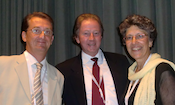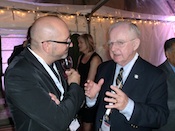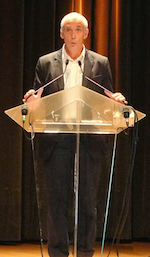The 11th World Congress on Endometriosis, with 1,294 delegates from 73 countries, was the biggest WCE ever! Over four days 102 oral abstracts were presented in 10 seminars and eight free communication sessions addressing both clinical and scientific conundrums. There were ten moderators’ lectures, six keynote lectures, four industry-sponsored seminars, one special seminar, and a debate. Every morning we met for breakfast to view the 374 posters also accepted for presentation.
At the Closing Ceremony, newly elected WES President, Paolo Vercellini, summed up the key messages from the meeting:
- The “endometriosis-adenomyosis syndrome” is caused by an abnormal uterus, and there is an urgent need for prospective studies to explore the importance and the role of alterations and disruption of the junctional zone in reproduction and obstetric outcome.
-

Professors Renaud de Tayra, Kevin Osteen, and Linda Giudice at the Seminar on Environmental Influences
There are several interactive environmental factors that may be involved in a woman’s risk of developing endometriosis.
- The magnitude of the association between endometriosis and ovarian cancer is moderate; the jury is still out as to whether or not endometriosis is a pre-neoplastic condition.
- Improving doctor/patient communication is crucial for determining appropriate diagnosis and accuracy of long term management.
-

Professors Anusch Yazdani and Ronald Batt in deep conversation
Differences between eutopic and normal endometrium contribute to the pathogenesis and symptomalogy of endometriosis, providing targets for novel therapeutic development.
- Studies on prevention are scarce. Although many possible behavioural changes can prevent occurrence, no adequate trial has been conducted yet.
- Post-operative OC use can play a fundamental role in tertiary prevention, but may be seen as a temporary measure.
- There is no single classification system on endometriosis which everyone can agree on; but the AAGL is now developing a surgical classification, which may impact surgical outcomes through improving data collection and recognition of surgical ability.
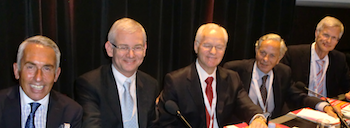
Professors Charles Miller, Mauricio Abrao, David Adamson, Alain Audebert, and Hans-Rudolf Tinneberg at the special seminar on the Classification of Endometriosis
-

Professor Michel Canis providing the background to the first WCE, held in 1986 (*)
The multiple interacting mechanisms underlying the pain associated with endometriosis require a multi-therapeutic approach.
- Large-scale international studies shed light on the considerable impact of endometriosis worldwide, and show the symptom-based predictability and genetic aetiology of moderate-to-severe disease.
- Sexuality is an important part of female health and is dramatically effected by endometriosis. There is an urgent need for more international studies using a common sexual health questionnaire.
- In endometriosis-related infertility, the therapy should be patient-specific and all the tools should be assessed and used as necessary.
- Endometriosis is not only a hormone-dependent disease but should be considered also as an inflammatory and neurologic disease.
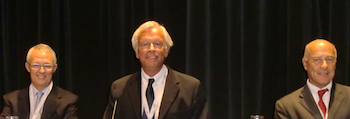
WES President Paolo Vercellini, WES Past President Hans Evers, WCE2011 President Bernard Hedon
- Centres of expertise!
- The –omics are the most rapidly developing areas of endometriosis research at present.
- It is better to have no surgery than bad surgery.
- In research excellence, clinical and scientific work must fuse!
Fusing clinical and scientific work

Participants in the WES/WERF Workshop on Research Priorities in Endometriosis on 4 September 2011
The last point was especially poignant, since it emphasised the work, which ~50 scientists came together to discuss prior to the Congress. The workshop on “Priorities in Endometriosis Research”, organised by Peter Rogers, followed up from the 2008 workshop. Sponsored by the World Endometriosis Society (WES) and World Endometriosis Research Foundation (WERF), this international gathering set out research priorities for 2011-2014, which are expected to be published in early 2012.
The day after the Congress a WES Consensus Workshop, organised by Neil Johnson and Lone Hummelshoj, included representatives from more than 30 international organisations from around the world, including patient societies.
The purpose of the workshop was to achieve consensus on how endometriosis can be managed best with the knowledge we have today with a focus on the impact of patient management and outcome with attention to the effectiveness and potential harms of any given treatment. Cost and availability of these treatments were considered where relevant.
The WES Consensus Statement will be submitted for publication in early 2012. Such a workshop has never before been conducted in the field of endometriosis and will no doubt be the first of several.
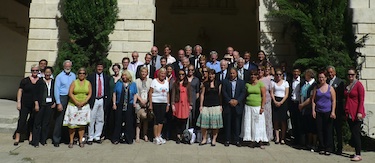
Participants at the 1st Consensus Meeting on Endometriosis, Montpellier Medical School, 8 September 2011 (*)
See also:
Eleven pioneers in endometriosis honoured at opening ceremony of WCE2011 →
Sawsan As-Sanie wins 2011 Rodolphe Maheux Award →
12th World Congress on Endometriosis (2014) →
(*) photos courtesy of Professor Karl-Werner Schweppe


